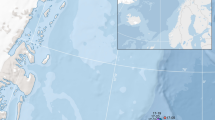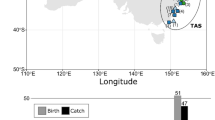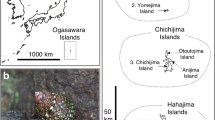Abstract
Population genetics is essential for understanding and managing marine ecosystems, but sampling remains challenging. We demonstrate that high-throughput sequencing of seawater environmental DNA can provide useful estimates of genetic diversity in a whale shark (Rhincodon typus) aggregation. We recover similar mitochondrial haplotype frequencies in seawater compared to tissue samples, reliably placing the studied aggregation in a global genetic context and expanding the applications of environmental DNA to encompass population genetics of aquatic organisms.
This is a preview of subscription content, access via your institution
Access options
Subscribe to this journal
Receive 12 digital issues and online access to articles
$119.00 per year
only $9.92 per issue
Buy this article
- Purchase on Springer Link
- Instant access to full article PDF
Prices may be subject to local taxes which are calculated during checkout

Similar content being viewed by others
References
Pierce, S. J. & Norman, B. Rhincodon typus. http://dx.doi.org/10.2305/IUCN.UK.2016-1.RLTS.T19488A2365291.en (IUCN, 2016).
Rowat, D. & Brooks, K. S. J. Fish Biol. 80, 1019–1056 (2012).
Robinson, D. P. et al. PLoS ONE 8, e58255 (2013).
Dicken, M. L., Booth, A. J. & Smale, M. J. ICES J. Mar. Sci. 63, 1640–1648 (2006).
Ficetola, G. F., Miaud, C., Pompanon, F. & Taberlet, P. Biol. Lett. 4, 423–425 (2008).
Thomsen, P. F. et al. Mol. Ecol. 21, 2565–2573 (2012).
Port, J. A. et al. Mol. Ecol. 25, 527–541 (2016).
Thomsen, P. F. et al. PLoS ONE 7, e41732 (2012).
Thomsen, P. F. & Willerslev, E. Biol. Conserv. 183, 4–18 (2015).
Robinson, D. P. et al. PLoS ONE 11, e0158593 (2016).
Castro, A. L. F. et al. Mol. Ecol. 16, 5183–5192 (2007).
Schmidt, J. V. et al. PLoS ONE 4, e4988 (2009).
Vignaud, T. M. et al. Mol. Ecol. 23, 2590–2601 (2014).
Kondrashov, F. A. & Kondrashov, A. S. Phil. Trans. R. Soc. B. 365, 1169–1176 (2010).
Valentini, A. et al. Mol. Ecol. 25, 929–942 (2016).
Fontes, J., McGinty, N., Machete, M. & Afonso, P. in QScience Proc. (The 4th Int. Whale Shark Conf.) Vol. 2016, iwsc4.17 (2016).
Meekan, M., Speed, C., Planes, S., McLean, C. & Bradshaw, C. Population Monitoring for Whale Sharks (Rhincodon typus) (Australian Institute of Marine Science, 2008).
Librado, P. & Rozas, J. Bioinform. 25, 1451–1452 (2009).
Meyer, M., Stenzel, U. & Hofreiter, M. Nat. Protoc. 3, 267–278 (2008).
Boyer, F. et al. Mol. Ecol. Resour. 16, 176–182 (2016).
Drummond, A. J., Suchard, M. A., Xie, D., Rambaut, A. Mol. Biol. Evol. 29, 1969–1973 (2012).
Watterson, G. A. Theor. Popul. Biol. 7, 256–276 (1975).
Tajima, F. Genetics 105, 437–460 (1983).
Nei, M. & Li, W.-H. Proc. Natl Acad. Sci. USA 76, 5269–5273 (1979).
Alam, M. T., Petit R. A. III, Read, T. D. & Dove, A. D. M. Gene 539, 44–49 (2014).
Schmidt, J. V. et al. Endang. Species Res. 12, 117–124 (2010).
Acknowledgements
We thank the Qatar Ministry of Environment for their collaboration and invaluable support. In particular, the crew on board R/V Saqt Al Khaleej is thanked for help with logistics for the water sampling. We thank the Maersk Oil Research and Technology Centre (MO-RTC) in Doha, Qatar, for being the main sponsor of the project. Special thanks to A. S. Al-Emadi (Head of MO-RTC) and J. Al-Khori (Technical Manager of MO-RTC) for supporting the project. The Danish National Research Foundation and the Natural History Museum of Denmark are thanked for additional funding. We thank T. B. Brand and the rest of the staff at the Centre for GeoGenetics, University of Copenhagen, as well as K. Magnussen and the Danish National Sequencing Centre for laboratory support. M. Krag is thanked for help with tissue samples. L. Olsen and P. Gravlund, National Aquarium Denmark (Den Blå Planet), provided a Stegostoma fasciatum tissue sample. J. V. Schmidt, University of Illinois at Chicago; R. W. Jabado, UAE University, Abu Dhabi, United Arab Emirates; and N. S. Blom, Danish Technical University, are thanked for scientific input. E. Vissing is thanked for the custom Python script.
Author information
Authors and Affiliations
Contributions
P.F.T., E.E.S., I.B.N., P.R.M. and S.S.B. conceived and designed the experiments. E.E.S., I.B.N., P.F.T., P.R.M. and S.S.B. performed the experiments. E.E.S., I.B.N., P.F.T. and M.W.P. analysed the data. E.E.S., P.F.T., P.R.M., S.S.B., E.D.L., D.P.R., S.W.K., M.W.P., M.A.J., L.O. and E.W. contributed materials or analysis tools. E.E.S., P.F.T., P.R.M., I.B.N., E.D.L. and S.W.K. wrote the paper.
Corresponding author
Ethics declarations
Competing interests
The authors declare no competing financial interests.
Supplementary information
Supplementary information
Supplementary Figures 1–11, Supplementary Experimental Procedures, Supplementary References. (PDF 1557 kb)
Supplementary Table 1
Overview of water samples used in this study. Related to Fig. 1c-f, and main text experimental procedures. Seawater eDNA samples collected for this study in the Arabian Gulf, off Qatar. Table includes sampling sites, collection dates, shark observations during eDNA sampling, total number of DL1 and DL2 sequences obtained from each water sample after data cleaning, haplotypes (DL1 and DL2) recovered from each water sample, and results from qPCR (number of positive qPCR replicates, average cycle threshold, average estimated eDNA concentration, and standard deviation of estimated eDNA concentration). (XLSX 20 kb)
Supplementary Table 2
Overview of tissue samples used in this study. Related to Fig. 1c-f, and main text experimental procedures.Whale shark tissue samples from Al Shaheen, Arabian Gulf, included in the study. Table includes tissue sample ID numbers, WildBook photo ID numbers (http://www.whaleshark.org), sex and size of sampled sharks, and haplotypes (DL1 and DL2) for the samples. *Bold red = individual was confirmed present on one or more of the eDNA sampling days: 27 May 2013, 28 May 2013, 19 May 2014, or 20 May 2014. (XLSX 13 kb)
Supplementary Table 3
Haplotype sequences used in this study. A list of all DL1 and DL2 haplotype sequences used in this study. Haplotype sequences include both the ones obtained from tissue and water samples as well as those retrieved from NCBI. For the DL2 sequences, they do not represent the complete fragment amplified by the primers, since the middle part has been removed bioinformatically due to low sequence quality (see Supplementary Experimental Procedures). *Indicates that the haplotype was recovered from one or more water samples. (XLSX 12 kb)
Supplementary Data 1
Input file for phylogenetic analysis of the DL2 fragment in BEAST. (XML 33 kb)
Supplementary Data 2
Input file for phylogenetic analysis of the DL2 fragment in BEAST, including only priors and no sequence data. (XML 22 kb)
Rights and permissions
About this article
Cite this article
Sigsgaard, E., Nielsen, I., Bach, S. et al. Population characteristics of a large whale shark aggregation inferred from seawater environmental DNA. Nat Ecol Evol 1, 0004 (2017). https://doi.org/10.1038/s41559-016-0004
Received:
Accepted:
Published:
DOI: https://doi.org/10.1038/s41559-016-0004
This article is cited by
-
Morphological and molecular analyses of a Philine kinglipini outbreak in summer of 2022 in Jiaozhou Bay, China
Journal of Oceanology and Limnology (2024)
-
Environmental DNA from soil reveals the presence of a “lost” Afrotherian species
Biodiversity and Conservation (2024)
-
Sensitive and efficient surveillance of Japanese giant salamander (Andrias japonicus) distribution in western Japan using multi-copy nuclear DNA marker
Limnology (2024)
-
Inadvertent human genomic bycatch and intentional capture raise beneficial applications and ethical concerns with environmental DNA
Nature Ecology & Evolution (2023)
-
Using eDNA to understand predator–prey interactions influenced by invasive species
Oecologia (2023)



